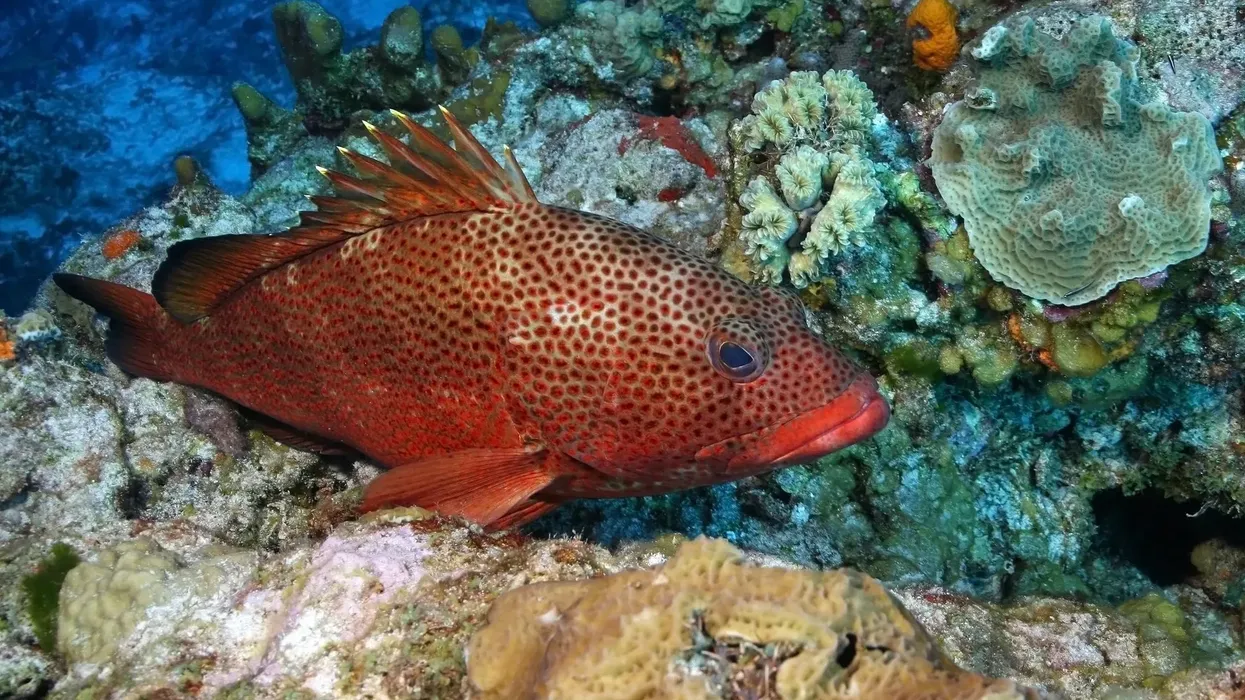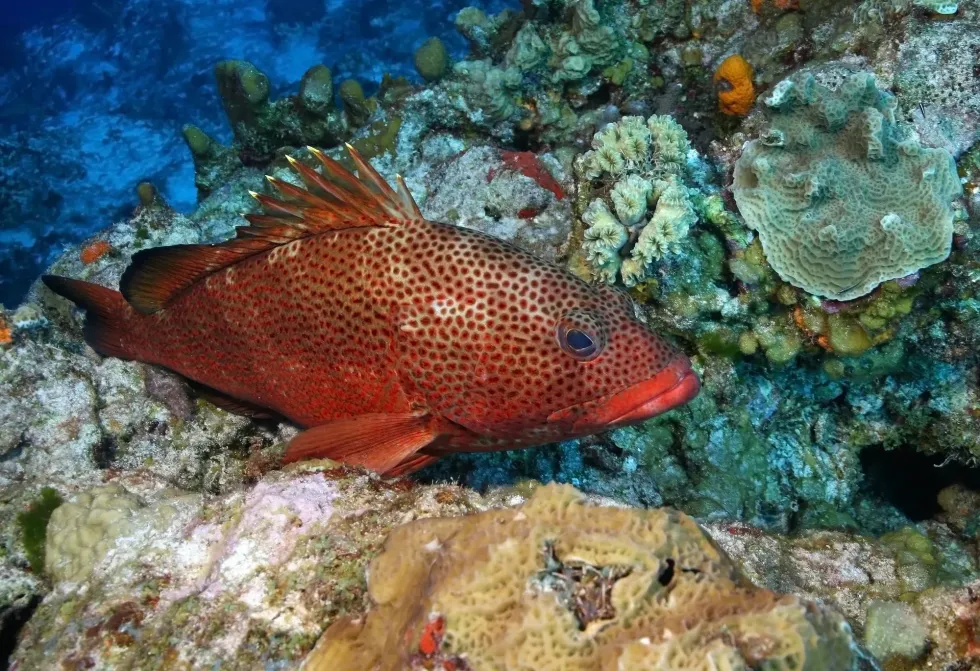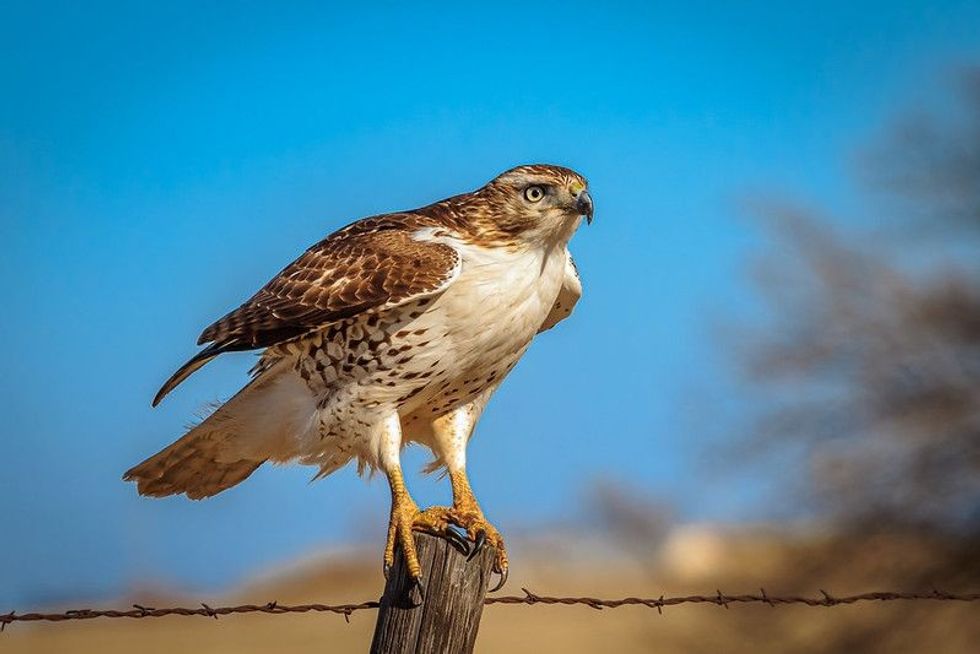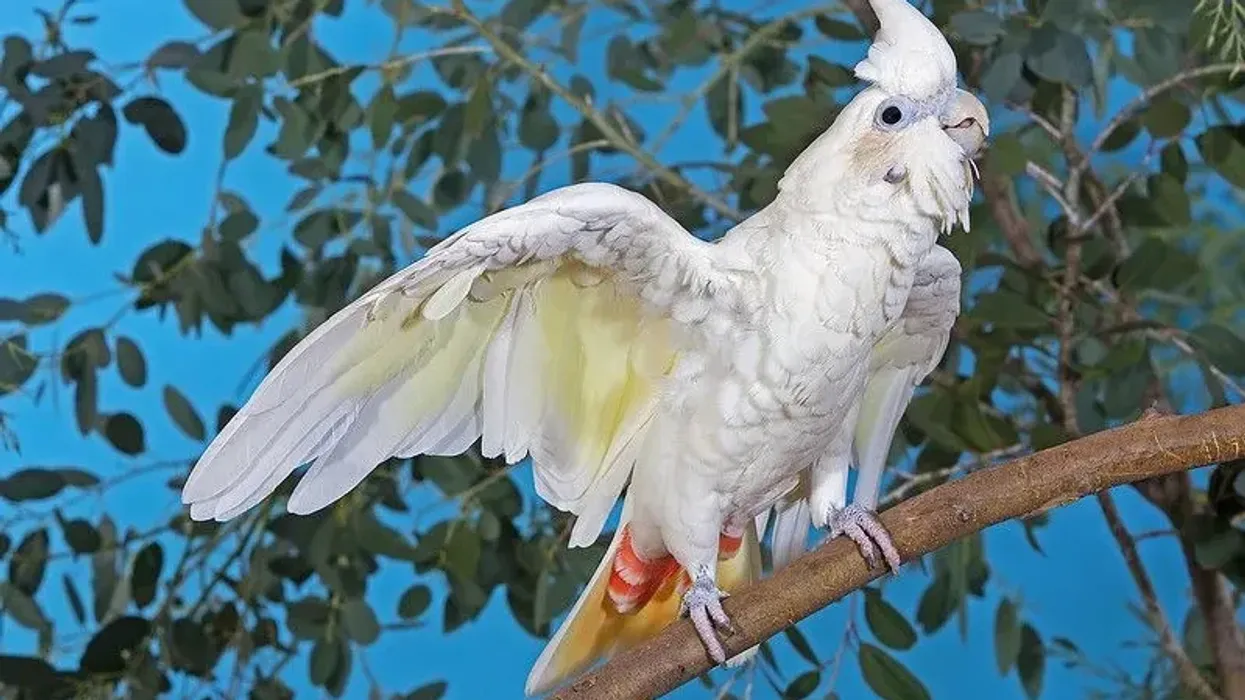Those who have traveled to the Caribbean would have most likely come across various grouper species present in their cuisine. One of the most common ones is the red hind (Epinephelus guttatus), which is locally known as the koon or the lucky grouper.
You may even get an invite to take part in fishing as it's locally available in many areas and the fish does have a good weight.
This grouper species is common in the western Atlantic and it's found from North Carolina in the USA to the Bermudas.
Other areas include the Gulf of Mexico, the Caribbean, and Brazil. This fish is known to live in coral reefs and rocky bottoms and the spots on its body help it to camouflage with its rocky habitat.
This hind has a compressed body with equidistant brown-red spots present all over its body. Interestingly, all red hinds are born as females, but some change into males at some point in time for successful mating.
Currently, the red hind has a strong population, and it's one of the most valuable commercial edible fishes of the Caribbean and western Atlantic. To know more about the red hind facts do keep reading this article.
Also, check out the articles on rainbow cichlid and sargo fish to know more about aquatic life.
Red Hind Interesting Facts
What type of animal is a red hind?
The red hind (Epinephelus guttatus) is a species of grouper fish that is predominantly found in the western Atlantic Ocean. This fish is also known by the names of lucky grouper and koon.
What class of animal does a red hind belong to?
The red hind belongs to the class Actinopterygii which contains other ray-finned fishes. This fish belongs to the family Serranidae and subfamily Epinephelinae which contains other groupers like the strawberry grouper.
How many red hinds are there in the world?
As the Epinephelus guttatus is a commercially raised fish, we don't really know the exact population of this grouper species.
Where does a red hind live?
The red hind lives natively in the western Atlantic ocean. Its spread over areas like the Bermuda, Caribbean, Puerto Rico, North Carolina and eastern United States, Mexico, the Gulf of Mexico, West Indies, and even to Brazil. However, its distribution is said to spread as far as Venezuela.
What is a red hinds’ habitat?
The lucky grouper (Epinephelus guttatus) resides in shallow coral reefs and rocky bottoms of the western Atlantic like in the Caribbean, North Carolina and other parts of its range. Males patrol its territory to make sure that the females are in place especially during the breeding reason.
This fish isn't a fast swimmer, and you are most likely to find it calmly resting behind a rock. This fish can live at a depth of up to 400 ft (122 m).
Who does red hind live with?
Like other groupers, the red hind is also a solitary fish and you won't usually find it in a school. But, at times the red hind can be seen with other similar grouper species like the rock hind present in the western Atlantic or Caribbean.
How long does a red hind live?
It's believed that the lucky grouper can live up to 50 years even in the wild. However, as it's often raised as human food, the fish may not live that far. Even in the wild, the red hind is a popular catch for hook and line fishing.
How do they reproduce?
One of the most interesting things about this grouper species is its way of reproduction. This fish has a unique life cycle as it's considered to be a protogynous hermaphrodites species.
It means that at some point in time the female red hind changes into a male fish. We are yet to know a lot about the reproduction system of this species.
However, in Puerto Rico, it has been observed that the fish gather in January and February for spawning. The fish usually gather along the insular shelf for spawning and it can last for one or two weeks.
The breeding time does change between different places but the spawning time is usually taken to be between December and March. It may stretch to July in Bermuda.
Some studies even show that the spawning period of the red hind syncs with the lunar cycle, especially the full moon. It's also believed that the fish may also make a kind of sound during gathering for spawning.
Scientists have also studied that the red hind may travel up to 18 mi (29 km) for spawning. These grouper females can lay up to 90,000-3,000,000 pelagic eggs in a single spawning season.
What is their conservation status?
The International Union for Conservation of Nature (IUCN) classifies the red hind (Epinephelus guttatus) in the category of Least Concern.
Red Hind Fun Facts
What does the red hind look like?
When it comes to the look of the red hind, it's quite similar to the other fish species present in the grouper family. The first thing you will notice is the flattened or compressed body along with protruding lips.
Other than that, the description of the red hind is incomplete without mentioning the numerous red spots and brown spots present all over its body. This fish has an overall red look which makes it different from the rock hind which has a primarily white body.
However, in the wild, the red hind may also have a greenish-gray tone to its body.
And, the lower side of its body is white. Another point of difference with the rock hind is the lack of spots on the dorsal fin and the anal fin.
One of the most significant features of this fish is its dorsal fin which contains eleven spines and up to sixteen rays. The depth of its body length is also the highest at the dorsal fin.
The anal fin has about three spines and eight soft rays, while the tail is slightly convex in shape. If you look closely, you will also notice that the dorsal fin and anal fin of this grouper has a dark brown border.

How cute are they?
You wouldn't think of the red hind as a cute fish, but it looks just as good as the nassau grouper.
How do they communicate?
It's quite hard to figure out ways in which a fish may communicate in its group. As a solitary fish species, this grouper fish may not have a huge need for communication.
But, scientists do believe that most fish can communicate via electrical impulses or even through tactile communication. Interestingly, the red hind males are said to make a unique sound, especially during the spawning season. Hence, we can expect to get more interesting studies about the red hind fish communication.
How big is a red hind?
The average body length range of the red hind is around 12-30 in (30.4-76.2 cm). In comparison, the red grouper attains an average body length range of 20-50 in (50.8-127 cm) making it much larger. While the rock hind, a similar species to the red hind has a body length range of 22.8-25 in (58-63.5 cm).
How fast can a red hind swim?
We don't really have any data about the swimming speed of these groupers, but as it's quite a lazy fish, we can assume that it doesn't swim at a very fast speed.
How much does a red hind weigh?
The average weight range of the red hind is around up to 49 lb (22.2 kg) making it a really great catch in fishing.
What are the male and female names of the species?
There are no separate names for females and males of this grouper species.
What would you call a baby red hind?
Just like other fish species, the baby of these hinds would be called fry.
What do they eat?
When it comes to the diet of this grouper, it has a taste for mantis shrimps and it can constitute up to 15% of its diet. Other than that, the grouper also feeds on crabs and fishes like bluehead wrasse, goatfishes, and even small morays. Occasionally, the diet can also range between octopuses, squids, and other kinds of shrimps.
Are they dangerous?
Not at all! This grouper fish is pretty harmless to humans as it cannot bite you. However, males can get pretty territorial during the spawning season and may go to all lengths to protect their habitat from intruders like other male grouper fish or other intruders.
Would they make a good pet?
If you have the space to rear these red hinds, then it can be a really good pet. Just make sure to give it the suitable red hind habitat and temperature, and it will surely become a great investment for you.
Before taking these groupers as your pet make sure to check if it's legal to farm the species in your area.
Did you know...
A tip for fishing is to lift the fish without pumping on the line as otherwise, you may lose the grouper because of its power and weight. Go slow and steady on the line, and you would be able to get a good fish.
You can also use a braided line to reach the depth where the fish lies, and try to search out places where there's a good distribution of rock beds.
The red hind is mostly active during dusk and dawn.
Even though fishing is quite common, it's usually restricted during the spawning season to let the fish breed. During this time, the fish is present in the water of low depth.
Moreover, even during the fishing season, always make sure to check the allowed bag limit for each person. In North Carolina, it's limited to three red hinds per day for one person.
Do they bite?
The red hind doesn't bite human beings. However, the word bite may also be quite significant in terms of fishing.
If that's what interests you, then yes, if the right kind of bait is used for this grouper it would definitely bite. Usually, hook and line fishing is used to catch the red hind fish, and it's known for having quite a bit of weight.
A double dropper loop is also said to be an effective way of fishing for the red hind.
The most suitable baits used for fishing includes squid, anchovies, and sardines. Make sure to use the right hook, and attach it in such a way that the grouper finds it natural.
Do humans eat them?
Yes, the red hind is a commonly caught fish, and it's enjoyed for the amount of meat that it provides. You can easily find this find in Caribbean cuisine. The meat quality of this fish is deemed to be near to excellent. In North Carolina, this fish can be caught between May to December.
Here at Kidadl, we have carefully created lots of interesting family-friendly animal facts for everyone to discover! For more relatable content, check out these devilfish facts and candiru facts for kids.
You can even occupy yourself at home by coloring in one of our free printable sunfish coloring pages.
Second image by Roban Kramer.










